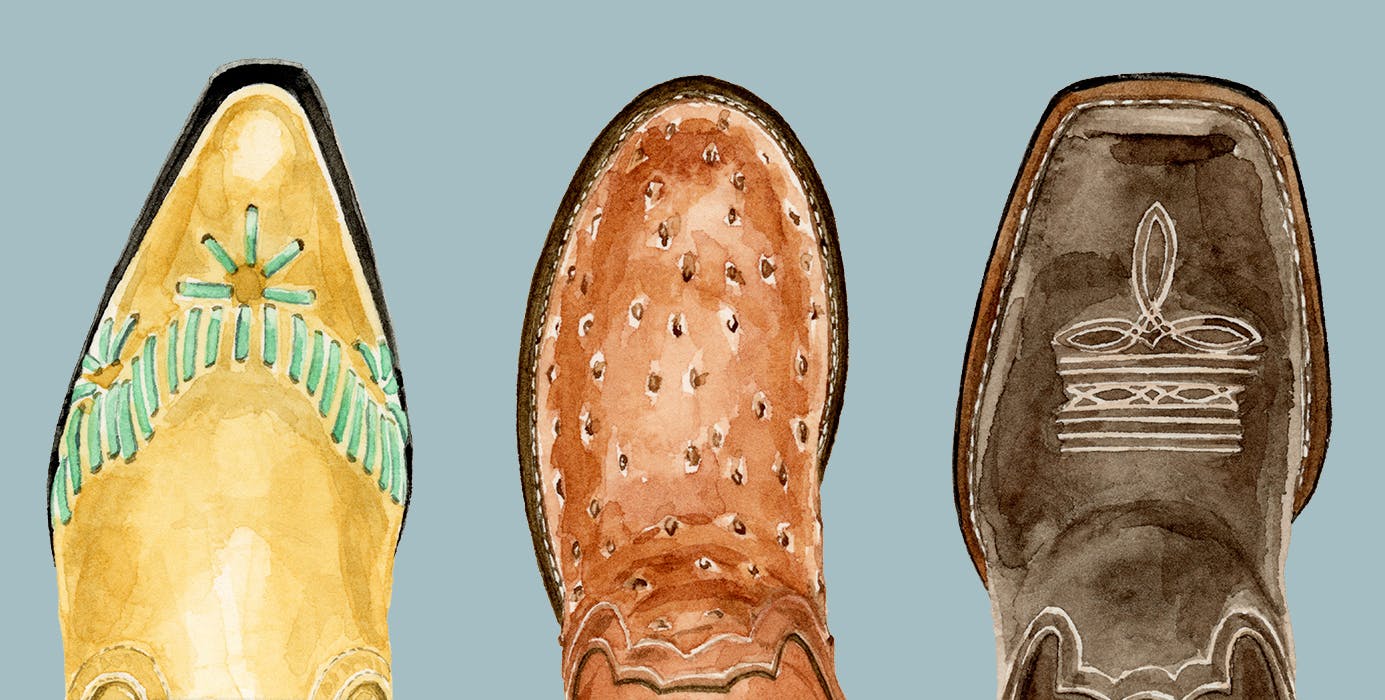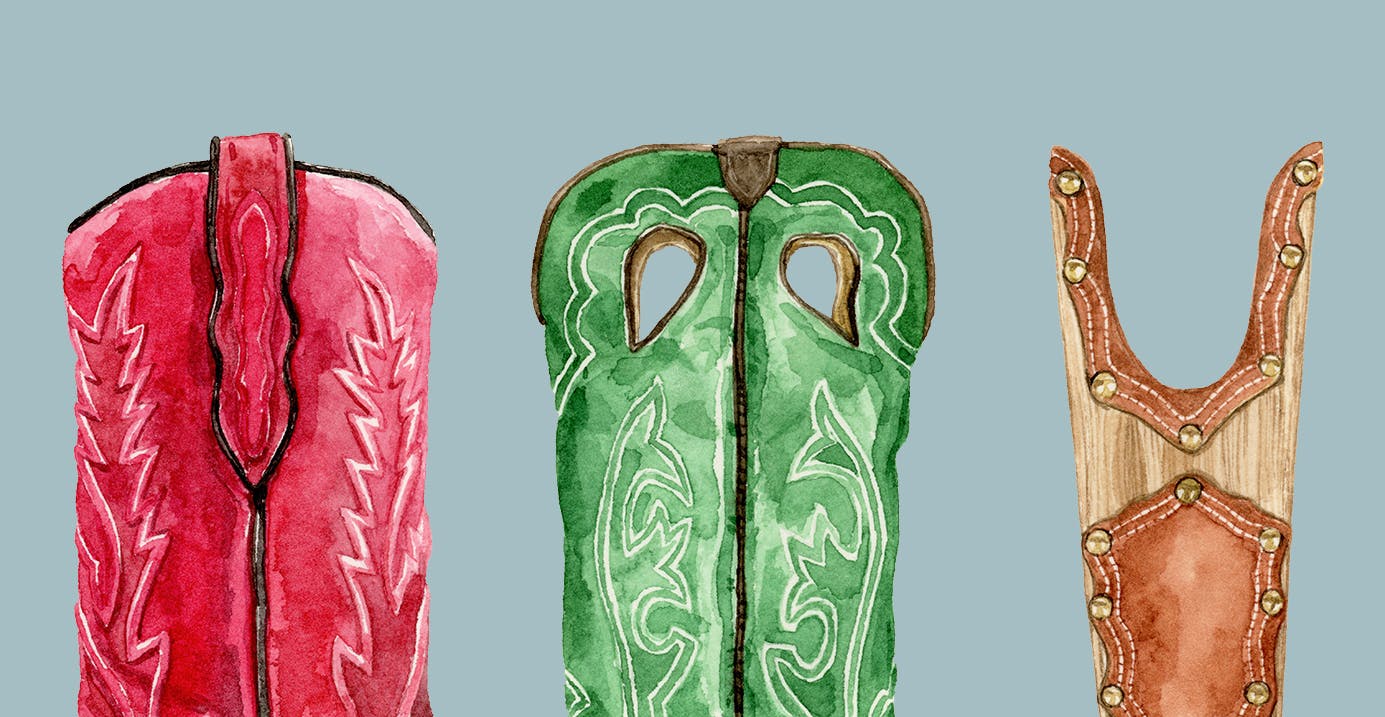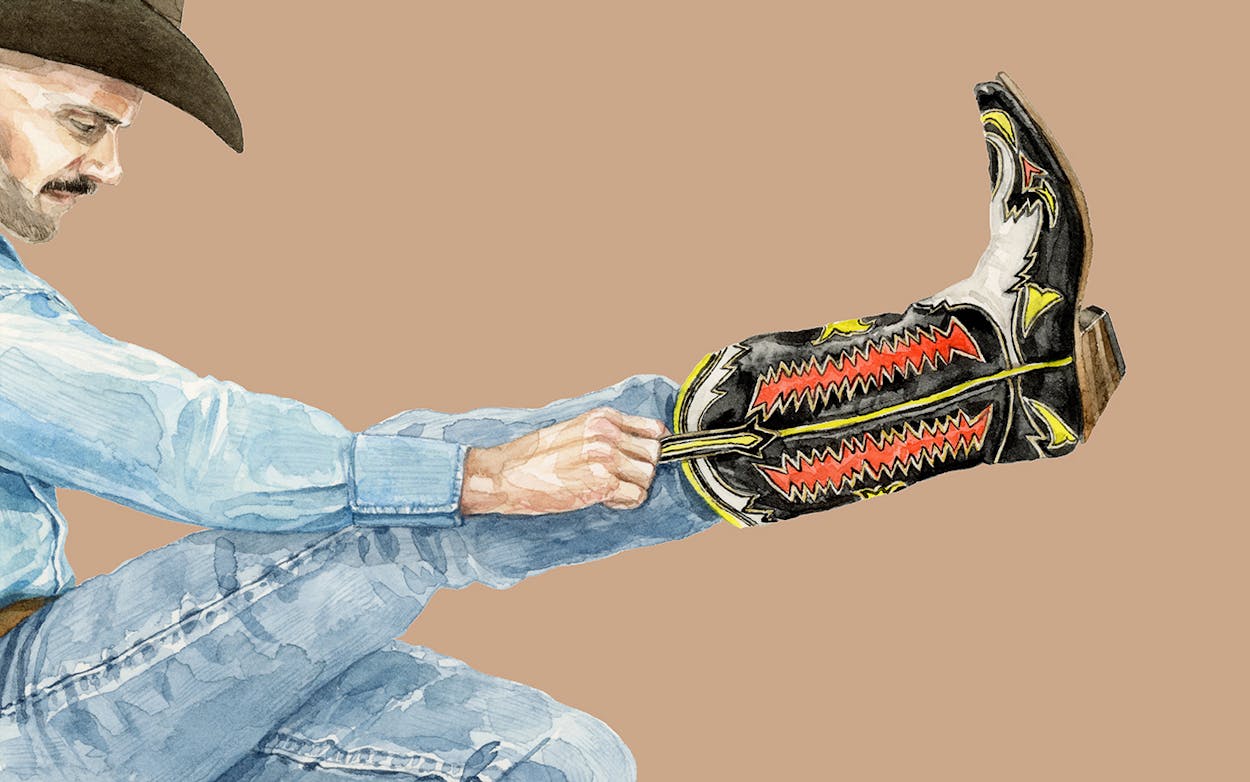Hello, and welcome! Won’t you please have a seat on the bench while an associate helps you find the perfect pair of cowboy boots to suit your needs? That’s right, settle in. Perhaps you’re already well versed in boot anatomy—you don’t have be told what a “toe bug” or a “wrinkle” is!—or maybe you just googled “cowboy boot what is that” and found us here? Either way, we’re here to help. First, there are considerations to be made, like: what are you actually going to be doing in these boots? Working cattle? Two-stepping? Presenting a TED talk? Walking a runway? Fixing a sewer system? Think on that. Second, consider what kind of statement you are hoping to make—and remember, please, that there is no such thing as “regular ol’ damn boots.” Decisions need to be made. So here are some categories for you to mull over.
Shaft height
While short-shafted booties are certainly trendy, the most popular style overall is the classic twelve-inch shaft. If you need something a few inches taller for one reason or another, you’re in the market for a buckaroo-style boot—that’s not something you can walk around town in easily, but they will help you with a kind of “Wild Bill” Hickok look.
Heel height
Generally speaking, you can select from two types of cowboy boot heels: the lower roper-style heel and the higher riding heel that’s 3/8-inch to 2 inches. “As far as height goes, a lot of people like roper heels because they’re close to a dress shoe,” explains Paul Hedrick, founder of Tecovas, “whereas a cowboy heel is an inch and a half higher than the average dress shoe and puts spring in your step and makes you a little taller.”

Toe style
The specific nomenclature of toe styles varies from maker to maker, but whatever you call them, the toes of your boots, whether they are pointy, round, or square, will say a lot about who you are, so think on this one:
1. Rounder toes, which come in a variety of roundness, are favored by those with slightly more conservative fashion sensibilities. Look for round toes on gentlemen and gentlewomen ranchers, business types, and everyday boot-wearers, too. If this is your first pair of boots (or if you’re worried about looking like you don’t know boots from galoshes), the traditional Western toe, which is rounded and narrow, is the toe for you.
2. Pointy toes, AKA roach killers, are thought of as the domain of rakes, rounders, rockers, fashionistas, and fashionistos. Snip toes are pointy toes that have been slightly squared off, or “snipped,” at the tips.
3. Square toes, which come in a variety of squareness, from subtle box toes to the broad square toes, have gained popularity over the past fifteen years. The “John Wayne” toe is a narrow square, also called a box toe, a punchy toe, or some other name depending on the company. The wide, square toe is the preferred choice for frat brothers, West Texas landmen, and rodeo cowboys.
Leathers
Here you choose from two categories: exotic or non-exotic. In the non-exotic division, you have cowhide (most popular), calf, goat (buttery feel), bison, bull, and pig. In the exotic department, the most sought-after leather is ostrich, which can be broken down into the following subgroups: full quill with pins (the most desired), smooth ostrich with no pins (from ostrich stomach), ostrich leg (looks reptilian), and ostrich neck (some combination of quill and smooth). American alligator is popular; some people go for the caiman instead, which has smaller, less uniform tiles. There’s rattlesnake and python, of course. Stingray is tough, so you have to buy it just right because it won’t stretch. You might also consider a new leather that has come out in the past eight years or so: a big freshwater fish with beautiful diamond-shape scales called a pirarucu. Bear in mind that the non-exotics will run $150 to $400 while the exotics can set you back anywhere from hundreds to thousands of dollars.
Fit
Everyone is going to tell you this, and it holds true: It should fit “like a firm handshake.” You want your toes flat with room to wiggle; still, it’s snug. Don’t panic if you experience a quarter-to-half-inch slip in the heel at first—that’s normal. As the insole of the boot breaks in and molds to your foot, that slip is going to subside. And before you attempt putting on a pair, you might ask for a boot-seller’s advice. “I had a big guy in the other day and he was sweating putting on boots and his foot was so big he muscled one on and it took me twenty-five minutes to get the boot off him,” said Ryan Stathos at Allen’s Boots in Austin. “I’m like the jaws of life here.”
Zippers
A lot of companies don’t put zippers on boots, maybe thinking that it wouldn’t seem like an authentic cowboy boot. But according to Hedrick at Tecovas, which started selling a zipper boot this year, it has proven popular. “People who have wider feet or a higher instep can have trouble getting inside tall cowboy boots,” said Hedrick. “A zipper solves that problem.”
Soles
Some customers prefer a rubber sole because it’s durable and comfortable, almost like a tennis shoe. Rubber stops a nail on a construction site better, it has less slide on sawdust, and gives you some protection while doing tasks like working on electrical problems in the rain. Fans of the traditional sole, on the other hand, prefer leather because it molds to your foot, and while a leather sole may seem slippery at first, it’ll scuff up in time and develop some traction. “Different strokes for different folks, but leather versus rubber comes into play mostly when people want to go dancing,” says Dillon Deckert, store manager for Cavender’s in South Austin. “If people want to dance, a leather sole is better for that.”

Pulls
Most boots have a version of the classic pull strap loops, whether they’re long mule ears or neat flush pulls, but you’ll still see some boots with “eyes” for hooking your fingers and pulling these suckers on. (Also: For removal, consider a boot jack.)
Inlays and Stitching
Traditional stitching was originally done in the late 1800s to help keep the shafts standing upright, though these days you can get crosses and skulls and flowers and anything else stitched up the side. What’s that, you want an image of your dog on these boots? Maybe your initials? A presidential insignia? For anything the bootmaker can’t do with stitching, you’ll require an inlay—that’s usually more of a custom boot element.
Can I Buy Boots Online?
While shops like Tecovas have built their business around selling boots online, the general rule with most boots is you’ve gotta try them on in person. Just as you don’t know what perfect brisket tastes like until you’ve had it in your mouth, you can’t judge what a boot is going to feel like until it’s on your foot. Find a professional, and at the end of the day, trust your gut. Nobody is going to arrest you if your personal preferences don’t match those of George Strait. You’re not King George, and he’s not you. As Deckert says, “If anything gets controversial with boots, the world is in a bad place.”
- More About:
- Style & Design
- Cowboy Boots








